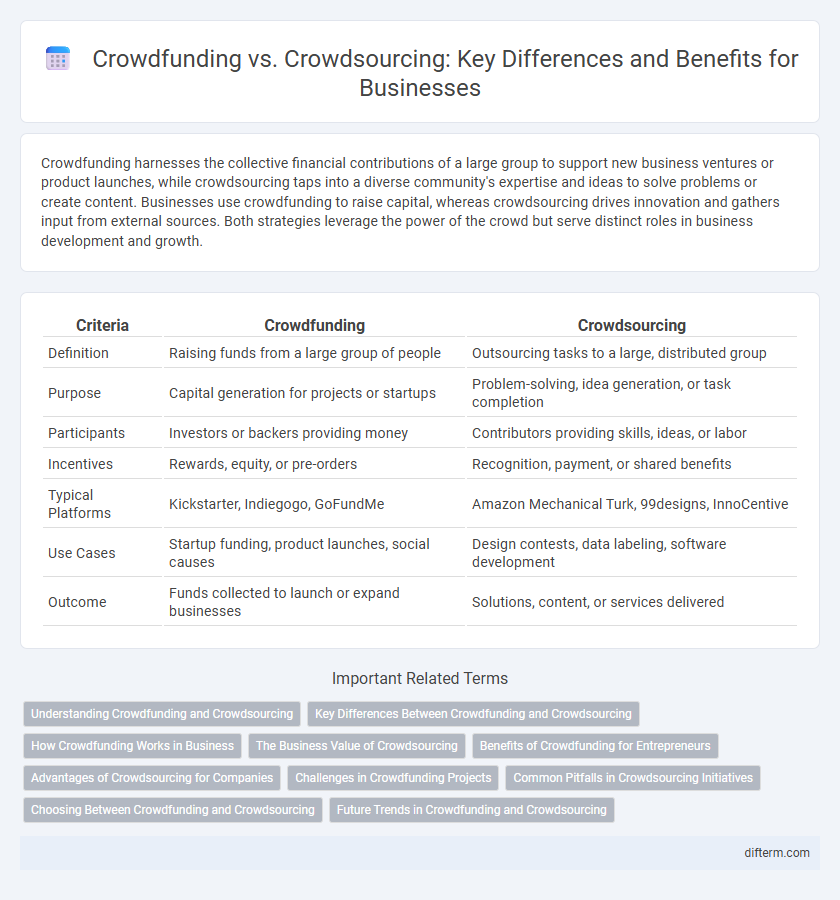Crowdfunding harnesses the collective financial contributions of a large group to support new business ventures or product launches, while crowdsourcing taps into a diverse community's expertise and ideas to solve problems or create content. Businesses use crowdfunding to raise capital, whereas crowdsourcing drives innovation and gathers input from external sources. Both strategies leverage the power of the crowd but serve distinct roles in business development and growth.
Table of Comparison
| Criteria | Crowdfunding | Crowdsourcing |
|---|---|---|
| Definition | Raising funds from a large group of people | Outsourcing tasks to a large, distributed group |
| Purpose | Capital generation for projects or startups | Problem-solving, idea generation, or task completion |
| Participants | Investors or backers providing money | Contributors providing skills, ideas, or labor |
| Incentives | Rewards, equity, or pre-orders | Recognition, payment, or shared benefits |
| Typical Platforms | Kickstarter, Indiegogo, GoFundMe | Amazon Mechanical Turk, 99designs, InnoCentive |
| Use Cases | Startup funding, product launches, social causes | Design contests, data labeling, software development |
| Outcome | Funds collected to launch or expand businesses | Solutions, content, or services delivered |
Understanding Crowdfunding and Crowdsourcing
Crowdfunding involves raising capital from a large number of individuals typically through online platforms to fund business ventures, product launches, or creative projects. Crowdsourcing leverages a diverse online community to gather ideas, services, or content, often enhancing innovation and problem-solving capabilities within organizations. Both strategies harness collective resources but serve distinct purposes: crowdfunding secures financial investment, while crowdsourcing focuses on collaborative input and expertise.
Key Differences Between Crowdfunding and Crowdsourcing
Crowdfunding involves raising capital from a large pool of individual investors to fund a specific project or business venture, while crowdsourcing leverages the collective intelligence or skills of a wide audience to solve problems or generate ideas. Key differences include the primary objective--funding versus problem-solving--and the nature of contributor involvement, with crowdfunding contributors providing financial support and crowdsourcing participants offering knowledge or labor. Platforms like Kickstarter exemplify crowdfunding, whereas crowdsourcing examples include platforms such as Wikipedia and Threadless, highlighting distinct approaches in leveraging crowd participation.
How Crowdfunding Works in Business
Crowdfunding in business involves raising capital by collecting small amounts of money from a large number of people, typically via online platforms like Kickstarter, Indiegogo, or GoFundMe. Entrepreneurs present their projects or products to potential backers who contribute funds in exchange for rewards, equity, or early access, enabling startups to validate ideas and gain market traction without traditional financing. This method leverages social networks and community engagement to reduce financial risks and accelerate business growth.
The Business Value of Crowdsourcing
Crowdsourcing leverages a diverse pool of external talent and ideas, enabling businesses to accelerate innovation and reduce operational costs. It enhances problem-solving capabilities by tapping into specialized skills and collective intelligence, driving product development and improving customer engagement. This approach fosters scalable collaboration, leading to increased agility and competitive advantage in rapidly evolving markets.
Benefits of Crowdfunding for Entrepreneurs
Crowdfunding enables entrepreneurs to access capital without traditional loans or investors, reducing financial risks and expanding funding opportunities. It also fosters a community of early supporters who provide valuable feedback and promote the product or service, accelerating market entry. This approach enhances brand visibility and validates business concepts through direct consumer engagement and demand testing.
Advantages of Crowdsourcing for Companies
Crowdsourcing enables companies to access a diverse pool of talent and ideas, leading to innovative solutions and improved problem-solving capabilities. It reduces operational costs by outsourcing tasks to a global community, enhancing efficiency without the need for extensive in-house resources. Engaging a wide audience through crowdsourcing boosts brand visibility and fosters customer loyalty by involving users directly in product development and decision-making processes.
Challenges in Crowdfunding Projects
Crowdfunding projects often face challenges such as inconsistent funding flow, which can delay project completion and affect investor confidence. Limited transparency and communication between project creators and backers may lead to misunderstandings and reduced trust. Managing diverse backer expectations while ensuring regulatory compliance also poses significant obstacles during campaign execution.
Common Pitfalls in Crowdsourcing Initiatives
Common pitfalls in crowdsourcing initiatives include ineffective participant engagement, unclear challenge definitions, and inadequate quality control mechanisms. Projects often suffer from poor communication, leading to misaligned goals and unmet expectations. Successful crowdsourcing requires transparent processes, well-structured tasks, and continuous feedback loops to harness collective intelligence effectively.
Choosing Between Crowdfunding and Crowdsourcing
Choosing between crowdfunding and crowdsourcing depends on the specific business goals: crowdfunding focuses on raising capital from a large pool of investors or customers, while crowdsourcing leverages the collective expertise and skills of a broader community to solve problems or generate ideas. Businesses seeking financial support for product development or expansion should prioritize crowdfunding platforms like Kickstarter or Indiegogo. Companies aiming to innovate, improve processes, or gather diverse input benefit from crowdsourcing models on platforms such as Innocentive or Topcoder.
Future Trends in Crowdfunding and Crowdsourcing
Future trends in crowdfunding highlight the integration of blockchain technology and decentralized finance (DeFi) platforms to enhance transparency and security for investors. Crowdsourcing is evolving with the rise of artificial intelligence and machine learning, enabling more efficient task distribution and real-time collaboration across global communities. Both models are expected to leverage data analytics and digital platforms to maximize engagement, innovation, and collective problem-solving in the business landscape.
Crowdfunding vs Crowdsourcing Infographic

 difterm.com
difterm.com